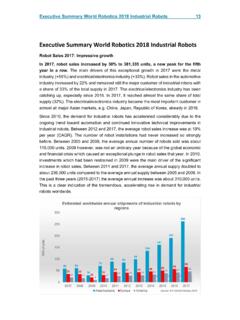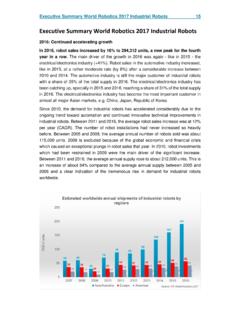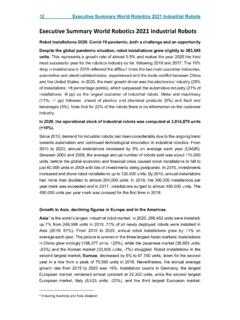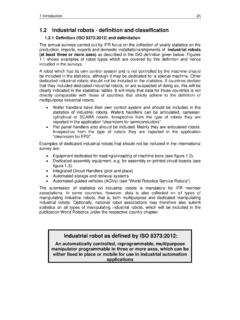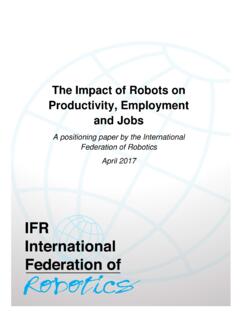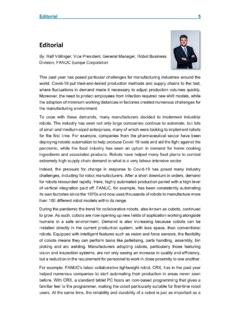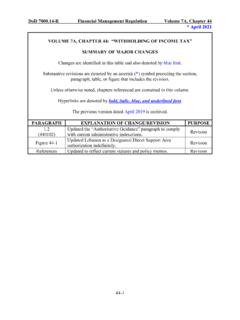Transcription of Executive Summary World Robotics 2021 - Service Robots
1 Executive Summary World Robotics 2021 - Service Robots 7. Executive Summary World Robotics 2021 - Service Robots The Service robot industry is more diverse and less tangible than the industrial robot industry. Despite a major clean-up and alignment to the new classification scheme (see chapter ), the list of Service robot suppliers (see chapter 4) grew to 1,067 companies worldwide with 17% of these being start-ups (established in 2016 or later). Many of these companies are still in the product development stage and do not have marketable products yet. These companies are still at the funding or prototyping stage and intend to offer a marketable product in the future.
2 The market for professional Service Robots grew in 2020 by 12% from a sample turnover of USD billion to USD billion. The global pandemic created new opportunities and additional demand for some Service robot applications, professional cleaning. Mobile robot solutions are already established in transportation and logistics (AP5). One out of three professional Service Robots sold in 2020 was built for the transportation of goods or cargo. Turnover in this segment grew by 11%. RaaS business models account for less than 3% of this. Demand for professional cleaning Robots (AP2) grew by 92% in terms of units sold and by 51% in terms of turnover.
3 Turnover of medical Robotics (AP6) was mainly driven by robotic surgery devices (AP62), which are the most expensive type of Service robot. Hospitality Robots (AP8) enjoy growing popularity. The Covid-19 pandemic created increased awareness to keep a minimum distance between staff members and avoid contact with food products. Robotics is an important part of digitalization in agriculture (AP1). Robots are established in cow milking (AP12), and there is a lot of research and development to use Robots for the cultivation (AP11) of plants and crops, which encompasses a variety of tasks. There are several robotic devices for inspection and maintenance (AP3) available, but the portfolio of Robots that conduct inspection and maintenance tasks autonomously is still limited.
4 Robots for construction or demolition (AP4) tasks constitute a small niche market. There are some innovative ideas on how to automate construction and demolition tasks, but the portfolio of marketable products is still limited. chapter 2 of World Robotics 2021 Service Robots provides a detailed analysis of IFR's annual survey among Service robot suppliers. chapter 3 provides detailed descriptions of the tasks that Service Robots can do, the state-of-the-art in applied research, cost-benefit considerations, and marketing challenges for each application class (see application class scheme in chapter 1), prepared by the Robotics experts at Fraunhofer IPA.
5 The Service robot industry is developing at a high pace. Lots of start-up companies appear every year, developing innovative Service robot applications and improving existing concepts. But it is also true that many of these young companies disappear as soon as they emerge. Some of them are acquired by incumbents, others are acquired by companies from other industries that want to expand into Service Robotics . Then again, there are those that just go out of business because they fail to develop a marketable product or there is insufficient demand for the specific product. All of this describes a young and growing industry with a rapidly developing technology.
6 chapter 4 of World 8 Executive Summary World Robotics 2021 - Service Robots Robotics 2021 Service Robots offers an industry structure analysis more than 1,000. Service robot suppliers currently known to the IFR. This includes a full list of all companies and the applications they provide. New this year: Customers of World Robotics Premium are now able to download this list in Excel format. Although the Service Robotics industry is a young and growing industry, 80% are considered incumbents. 47% of the Service robot suppliers are from Europe, 27% from (North) America, and 25% from Asia. There are only a few Australian and African companies.
7 82% of the companies are classified as professional Service robot suppliers, and 25% are classified as consumer Service robot suppliers (total exceeding 100%. because companies can be attributed to both categories). The United States is home to the most Service robot suppliers, followed by Germany, China, Japan, and Russia. Worldwide, 82% of the companies are small or medium-sized enterprises (SME) with up to 500 employees.
